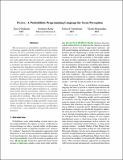Picture: A Probabilistic Programming Language for Scene Perception
Author(s)
Kulkarni, Tejas Dattatraya; Tenenbaum, Joshua B.; Mansinghka, Vikash K.; Kohli, Pushmeet
DownloadTenenbaum_Picture A.pdf (2.295Mb)
OPEN_ACCESS_POLICY
Open Access Policy
Creative Commons Attribution-Noncommercial-Share Alike
Terms of use
Metadata
Show full item recordAbstract
Recent progress on probabilistic modeling and statistical learning, coupled with the availability of large training datasets, has led to remarkable progress in computer vision. Generative probabilistic models, or “analysis-by-synthesis” approaches, can capture rich scene structure but have been less widely applied than their discriminative counterparts, as they often require considerable problem-specific engineering in modeling and inference, and inference is typically seen as requiring slow, hypothesize-and-test Monte Carlo methods. Here we present Picture, a probabilistic programming language for scene understanding that allows researchers to express complex generative vision models, while automatically solving them using fast general-purpose inference machinery. Picture provides a stochastic scene language that can express generative models for arbitrary 2D/3D scenes, as well as a hierarchy of representation layers for comparing scene hypotheses with observed images by matching not simply pixels, but also more abstract features (e.g., contours, deep neural network activations). Inference can flexibly integrate advanced Monte Carlo strategies with fast bottom-up data-driven methods. Thus both representations and inference strategies can build directly on progress in discriminatively trained systems to make generative vision more robust and efficient. We use Picture to write programs for 3D face analysis, 3D human pose estimation, and 3D object reconstruction – each competitive with specially engineered baselines.
Date issued
2015Department
Massachusetts Institute of Technology. Department of Brain and Cognitive SciencesJournal
Proceedings of the IEEE Conference on Computer Vision and Pattern Recognition, CVPR 2015
Publisher
Institute of Electrical and Electronics Engineers (IEEE)
Citation
Kulkarni, Tejas D., Pushmeet Kohli, Joshua B. Tenenbaum, Vikash Mansinghka. "Picture: A Probabilistic Programming Language for Scene Perception." Forthcoming in the proceedings of the IEEE Conference on Computer Vision and Pattern Recognition (CVPR), Hynes Convention Center, Boston, MA, June 7-12, 2015.
Version: Author's final manuscript
ISBN
978-1-4244-3992-8
ISSN
1063-6919
2332-564X